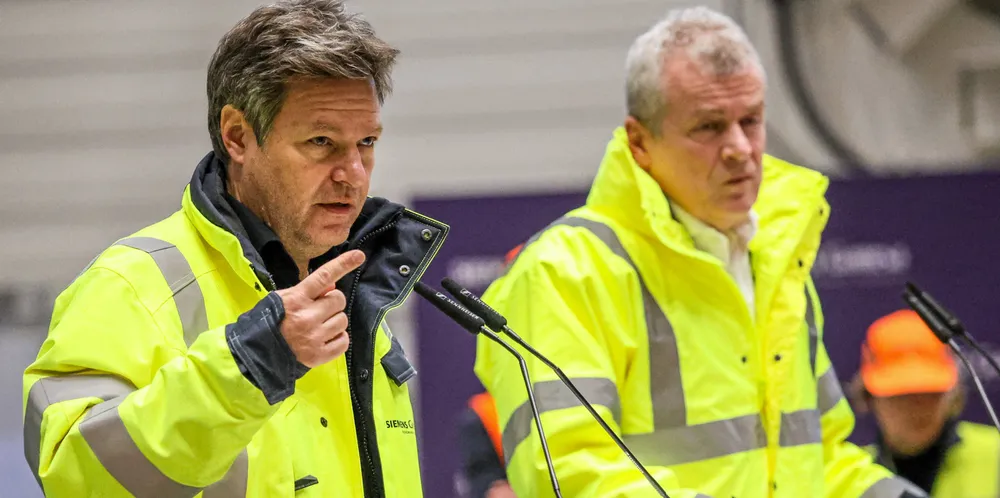'We're not asking for subsidies' | So what help does Europe's embattled wind industry actually want?
ANALYSIS | Loss-making turbine makers have differing demands ranging from direct cash to new tender rules – but they all agree the need is urgent, writes Bernd Radowitz

Europe’s wind turbine manufacturers are all loss-making just when governments want them and their suppliers to massively ramp up production or even build entire new factories so that they can meet ambitious climate goals and diminish dependence on Russian energy imports.
And even if, somehow, the time-gap can be bridged until renewables targets translate into massive new wind turbine orders, new threats are looming on the horizon.
Already 2.8GW of Chinese turbines have been installed in Europe or are in the project development phase (mostly in Serbia, Romania, and Italy), said Dennis Rendschmidt, managing director at VDMA Power Systems, a group representing wind OEMs in Germany and their suppliers.
It is not surprising that companies are demanding help. But what kind of aid does Europe’s wind sector want, and are subsidies a smart idea?
Lack of consensus
There doesn’t seem to be a consensus in the industry on that.
Jürgen Zeschky, CEO at German turbine maker Enercon, takes a middle ground.
Such a level playing field is not given, if Chinese OEMs offer developers cut-throat prices backed by cheap state financing and the option to only pay once a turbine is installed.
Wind power tendering designs, therefore, should abandon the idea of going for the cheapest price only and incorporate qualitative criteria, Zeschky said, a demand widespread in the wind sector. If the ‘Made in Europe’ label has a value and an independent energy supply is seen as crucial by governments and society, that should be reflected in auctioning designs, he reckoned.
Zeschky didn’t detail what giving value to ‘Made in Europe’ wind turbines means, but the easiest way to guarantee that would be through some kind of points system for local content in tenders.
Given the US’s unashamed tax breaks for turbines from local production and various types of Chinese favouring of local companies or the obligation for foreign players to enter joint ventures in China, local content rules in European auctions probably wouldn’t be difficult to justify under World Trade Organisation (WTO) rules.
Devil in the detail
But the devil sits in the detail of how local content will be measured.
Would turbines qualify that are only assembled in Europe, but from components mostly from overseas, and in particular from China? Or would a large share of components also need to come from European suppliers?
Dimitri Schneider, managing director at GE Renewable Energy’s wind turbine factory in Salzbergen, Germany, at a VDMA Power System’s panel at the Husum Wind event last week also called for qualitative and pre-qualification criteria at tenders to prevent wind manufacturing in Europe suffering the same fate as solar panel making earlier.
But Schneider also admitted that there is a strong dependency on Chinese suppliers throughout the industry. In the case of GE in Germany, some 60% of direct or indirect materials for wind turbines come from the Asian superpower – particularly very large components needed for onshore and offshore wind manufacturing made from steel or cast iron, as well as other raw materials.
Given that fact, it is important to make sure that new tendering criteria “don't drive up the price,” he said.
“That means we simply must design the competition so that everyone plays according to the same guidelines. But wind power must not become more expensive. [That is] easier said than done,” he acknowledged.
VDMA’s Rendschmidt said his group thinks that if governments and society want to achieve the energy transition with European manufacturers and keep technical know-how and jobs at home, then Europe should “not become dependent on external supply chains.”
It should also be checked if foreign players keep a minimum of environmental and labour standards, and don’t close off their own market to European companies as China often is doing, he said.
But Rendschmidt is aware that local content is difficult to measure.
“Where do you actually cut off? … Does the factory gate where the machine ultimately rolls out have to be in Germany? Or does a certain proportion of value creation have to take place in Germany or Europe? Can it be ensured that the added value also happens here in Europe, but also with European workers?” he asked.
“And how heavily are [companies] subsidised from the domestic market? Even if [OEMs] now open a factory in Europe, one must ensure that they are not so subsidised by China, that they again use unfair means in this market.”
Rendschmidt admitted that those auctioning criteria are “not that easy to implement.”
German economics and climate minister Robert Habeck said his government is in talks with the wind industry to find a way out of the sector’s valley of tears.
Enercon’s Zeschky said such guarantees in principle could help his company “to do a steeper ramp-up” of production.
But he added that so far Habeck’s ideas are “framework” with the detailed “regulation still in the works.”
Germany and the EU shouldn’t wait too long to flesh out which form of aid they are willing to grant their domestic wind industry, or it might be gone.
(Copyright)